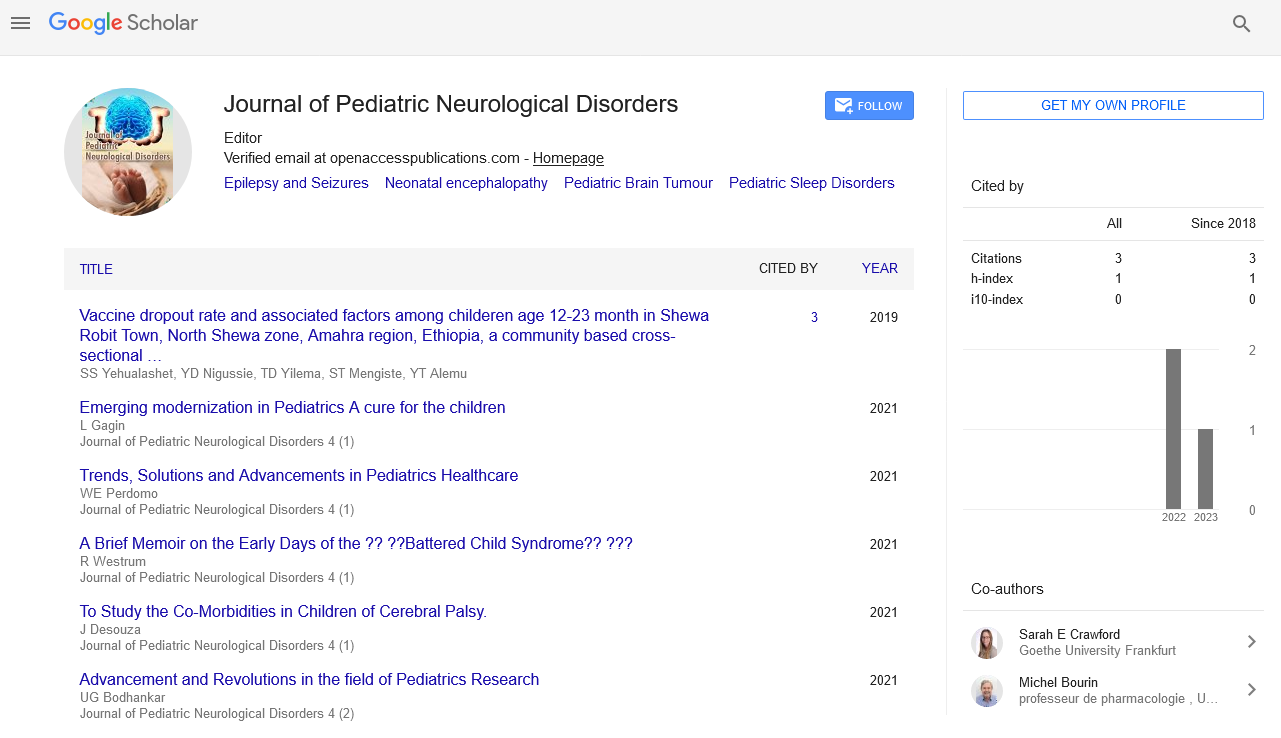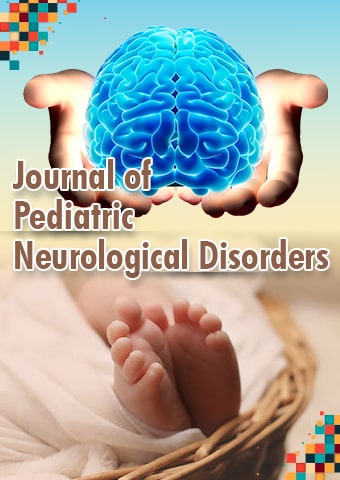Mini Review - Journal of Pediatric Neurological Disorders (2023) Volume 6, Issue 3
Treatment of Febrile Seizures in Children
Julian August*
Department of Neurology, Universidade do Porto
Department of Neurology, Universidade do Porto
E-mail: augustjulian@udp.ac.pt
Received: 01-June-2023, Manuscript No. pnn-23-103695; Editor assigned: 05-June-2023, PreQC No. pnn-23- 103695(PQ); Reviewed: 19- June- 2023, QC No. pnn-23-103695; Revised: 21-Apr-2023, Manuscript No. pnn-23-103695; Published: 28-June-2023, DOI: 10.37532/ pnn.2023.6(3).57-59
Abstract
Children aged six months to six years can experience Febrile Seizures (FS), which are manifestations of a fever without an intracranial infection, hypoglycemia, or an acute electrolyte imbalance. FS are the most widely recognized kind of seizures in kids. Even though FS are generally harmless for children, they can be extremely frightening for parents, making it crucial to address parental anxiety in the most sensitive manner. The management of FS in children was the primary focus of this review. The majority of children with FS have a good prognosis and few experience long-term health issues, according to research. Clinical FS is the diagnosis, and it's critical to rule out intracranial infections, especially after a complex FS. Controlling the symptoms and treating the fever are the two aspects of management. After a FS, parents and other caregivers often feel helpless and scared, so it's important for medical professionals to provide them with the right information and direction on how to treat their child's fever. Pediatricians and neurologists need to learn more about FS management and standardize the diagnostic and therapeutic workup because diagnostic tests and treatments are often used incorrectly
Keywords
Febrile seizures • Electrolyte imbalance • Parental anxiety • Intracranial infection • Long-term health issues • Child’s fever
Introduction
Fever is the cause of Febrile Seizures (FS), which are seizures or convulsions that occur in children aged six months to six years. FS are the most widely recognized kind of seizures in kids. Their predominance is roughly 3%-4% in white youngsters, 6%-9% in Japanese kids, and 5%-10% in Indian kids. Even though FS are generally harmless for children, they can be extremely frightening for parents, so it is important to address parental anxiety with compassion. Although some studies suggest a possible connection with environmental and genetic factors, the precise causes of FS remain a mystery. The release of high levels of cytokines during a fever may alter normal brain activity and cause seizures. Fever is a normal response to infection, Male gender, a family history of FS, an elevated peak body temperature, specific underlying causes of the fever, prenatal and natal complications, low serum calcium, sodium, or blood sugar, microcytic hypochromic anemia, and deficiencies in iron and zinc are all risk factors for FS . Indar Kumar and others hypothesised that reducing the incidence of FS by optimizing its reducible risk factors. Even though an autosomal dominant inheritance pattern of a clearly defined "febrile seizure susceptibility trait" has been identified in some families, other studies demonstrated that FS are associated with a polygenetic inheritance. Last but not least, FS may be caused by mutations in the genes that make sodium channels and the amino butyric acid A receptor. Chickenpox, influenza, middle ear infections, upper and lower airway infections (like tonsillitis, pneumonia, bronchitis, and sinusitis), tooth infections, and gastroenteritis (especially those caused by rotavirus) are the most common infections associated with FS in children [1].
Clinical manifestation
In children in Western Europe and the United States, the peak age of onset for FS is 18 months, with a prevalence of 2%–5%. Half of all children with FS are between the ages of 12 and 30. Only 6% to 15% of children over the age of four experience their first episode of FS. FS can affect children of any ethnicity, but it is more common in some groups, especially Guamanians (14%), Japanese (6%–9%), and Indians (5%–10%) [2].
Although children can experience seizures at any time during a febrile illness and may only experience a fever following a seizure, FS typically occur when the child's temperature is greater than 38 degrees Celsius. Loss of consciousness, difficulty breathing, pallor or blueness, foaming at the mouth, rolling of the eyes to the back of the head, fixed gaze, generalized or focal twitching, and jerking of the arms and legs are typical FS symptoms. Children may be irritable, confused, or drowsy after a seizure, but they will recover completely within 30 minutes. The two primary types of FS are: Complex FS and simple FS, which account for 70% of all FS and typically do not have any long-term neurodevelopmental effects, outline the characteristics of simple and complex FS. An FS that lasts longer than 20 minutes and typically necessitates the administration of anticonvulsants to end is known as febrile Status Epilepticus (SE) [3].
Diagnosis
To rule out secondary causes of convulsions in a child with FS who presents to the Emergency Department (ED), it is critical to first obtain a thorough and accurate history and to conduct a comprehensive clinical evaluation, including a neurologic examination. The nature and duration of the convulsions, as well as the presence and duration of the post-ictal phase, recent infectious diseases or fevers, recent antibiotic therapy, other associated symptoms, immunization and vaccination history, a history of previous episodes of FS or a diagnosis of epilepsy, other neurologic conditions and diseases, a family history of FS, epilepsy, or neurologic diseases, the use of antipyretics, and the requirement for rescue anticonvulsants to interrupt seizures, The goal of the clinical evaluation ought to be to locate the infection that is causing the fever. If the child continues to convulse, emergency stabilization using the ABCDE approach (airway, breathing, circulation, disability, exposure/examination, and blood glucose check) is necessary, and antiepileptic medication should be administered as soon as possible. The following vital signs should be taken after stabilization: temperature, heart rate, respiration rate, capillary refill time, and glucose levels in the blood. The signs and symptoms of intracranial infections like meningitis or encephalitis, which can be very subtle in young children, need to be ruled out right away. Brain abscesses are uncommon in children and occur in 25% of children younger than 15 years of age, peaking between the ages of 4 and 7. 25%–50% of patients have seizures, focal neurologic deficits, and altered mental status, but symptoms may not be apparent.
If the abscess is visible on the brain Magnetic Resonance Imaging (MRI), a lumbar puncture is not necessary. This is because MRI is the preferred diagnostic method [4, 5].
The treatment consists of taking antibiotics and having the abscess surgically removed. Streptococci, staphylococci, and enteric bacteria are the most common organisms that cause brain abscesses. However, the role that communityacquired Methicillin-Resistant Staphylococcus aureus (MRSA) has played over the past decade is of greater concern [6, 7].
To avoid confusing post-ictal electrical activities with abnormal electrical activities, an EEG should be performed at least 48 hours after the FS. Furthermore EEG easing back was not a critical indicator of epilepsy. As a result, patients at risk for epilepsy are unlikely to be identified by early EEG abnormalities following a first complex FS [8]. The age of the patient, the timing of the EEG and genetic syndromes are all likely to play a role in the occurrence of EEG abnormalities. Children who present with recurrent episodes of simple FS and have a clear source of infection do not need to repeat this test, but it is important to accurately identify the infection's source and manage it appropriately [9, 10].
Conclusion
Clinicians and parents/caregivers frequently express concern regarding the recurrence of FS, particularly the possibility of epilepsy onset. Simple FS does not affect behavior, academic performance, or neurocognition, but it may slightly raise the risk of epilepsy. Children who have a family history of complex FS are more likely to develop epilepsy. A second episode of a future febrile illness will occur in one third of children who present with one FS. A positive family history of FS, a first FS before the age of 18 months, a first FS less than one hour after the onset of a fever, and FS at a body temperature of less than 38 C are all risk factors for the recurrence of FS. Recurrence of febrile seizures occurs in 75% of children with previously identified risk factors, compared to 4% of children without risk factors. To counsel the child's parents or other caregivers and to administer rescue antiepileptics to children who have a high risk of recurrence, it is essential to be aware of the risk factors for FS recurrence.
References
- Guedj R, Chappui H, Titomanlio L. Risk of Bacterial Meningitis in Children of 6 to 11 Months of Age with a First Simple Febrile Seizure: A Retrospective, Cross-sectional, Observational Study. Off J Soc Acad Emerg Med. 22, 1290-1297 (2015).
- Waruiru C, Appleton, R. Febrile Seizures: An update. Arch Dis Child. 89, 751-756 (2004).
- Paul SP, Blaikley S, Chinthapalli R. Clinical update: Febrile convulsion in childhood. Community Practitioner. 85, 36-38 (2012).
- Myers KA, Scheffer IE, Berkovic SF. ILAE Genetics Commission. Genetic literacy series: Genetic epilepsy with febrile seizures plus. Epileptic Disord. 20, 232-238 (2018).
- Zhang YH, Burgess R, Malone JP, et al. Genetic epilepsy with febrile seizures plus: Refining the spectrum. Neurology. 89, 1210-1219 (2017).
- Sadleir LG, Scheffer IE. Febrile Seizures. Br Med J. 334, 307-311 (2007).
- Lux A. Antipyretic drugs do not reduce recurrences of febrile seizures in children with previous febrile seizure. Evid Based Med. 15, 15-16 (2010).
- Remick K, Regdate C, Ostermayer D. Prehospital Glucose Testing for Children with Seizures: A Proposed Change in Management. Prehosp Emerg Care. 21, 216-221 (2016).
- Harini C, Nagarajan E, Kimia AA. Utility of initial EEG in first complex febrile seizure. Epilepsy Behav. 52, 200-204 (2015).
- Strengell T, Uhari M, Tarrka R. Antipyretic agents for preventing recurrences of febrile seizures: Randomized controlled trial. Arch Pediatr Adolesc Med. 163, 799-804 (2009).
Indexed at, Google Scholar, Crossref
Indexed at, Google Scholar, Crossref
Indexed at, Google Scholar, Crossref
Indexed at, Google Scholar, Crossref
Indexed at, Google Scholar, Crossref
Indexed at, Google Scholar, Crossref
Indexed at, Google Scholar, Crossref
Indexed at, Google Scholar, Crossref

